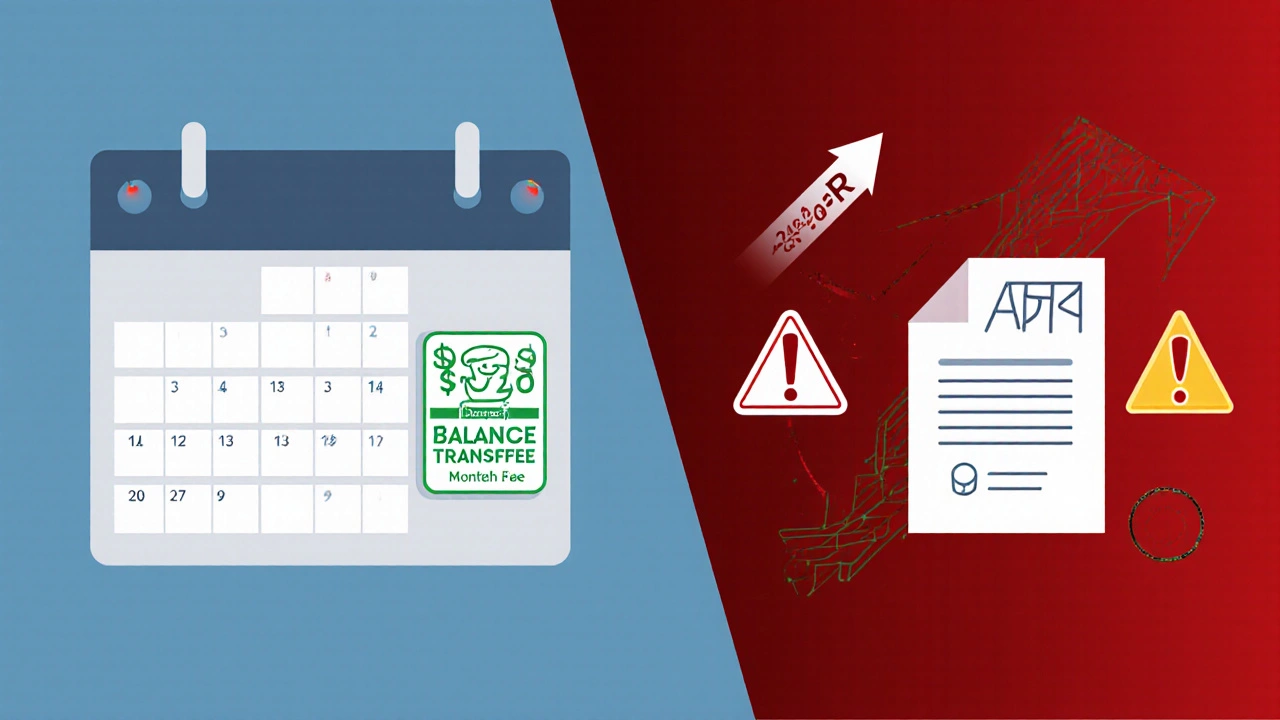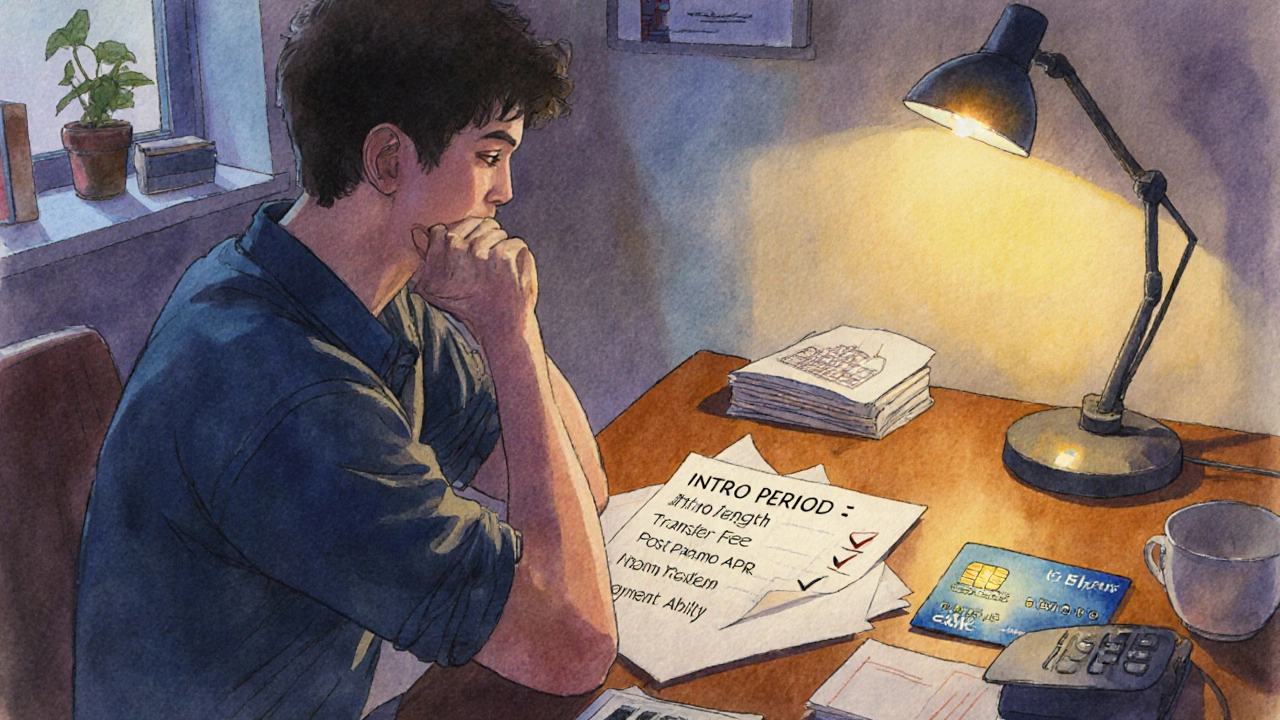Balance Transfer Cost Calculator
Calculate Your Balance Transfer Costs
Results
Enter your details above to see how much you could save or lose with a balance transfer.
With Your Current Card
$0.00 total interest over 12 months
With 0% APR Card
Balance Transfer Fee: $0.00
Total Paid During Intro: $0.00
Interest After Intro: $0.00
Total Cost: $
You'll save $0.00 with this transfer
Ever signed up for a 0% APR credit card because the headline looked too good to miss? You’re not alone. Zero‑interest promises feel like a free ride, but the fine print often hides costs that can drain your finances faster than a regular card.
What exactly is a 0% APR credit card?
0% APR credit card is a type of credit card that offers an introductory period with no interest charged on purchases or balance transfers. The interest‑free window usually lasts between 6 and 18 months, after which a standard APR kicks in. During the promo period you can borrow without paying the usual APR (annual percentage rate, the yearly cost of borrowing expressed as a percentage. It sounds perfect-until the clock runs out.
Why the appeal can be misleading
Zero‑interest offers attract shoppers who want to spread out big purchases or move existing debt onto a cheaper card. The lure is strong, but three hidden factors often turn the deal sour:
- Balance transfer fees. Most cards charge 3‑5% of the amount moved, even though the balance itself won’t earn interest.
- Short intro periods. Miss the deadline and the remaining balance jumps to a high standard APR, sometimes 20% or more.
- Late‑payment penalties. A single missed payment can erase the 0% rate and add a hefty late fee.
How fees stack up over time
Imagine you transfer $5,000 from a 20% APR card to a 0% APR card with a 3% fee and a 12‑month intro period. The fee costs $150 upfront. If you pay off the balance evenly over the year, you’ll pay $250 per month. By month 13 the remaining $1,000 is hit with a 20% APR, adding $17 in interest that month alone. In total, you’ve paid $150 fee + $1,500 in monthly payments + $17 interest = $1,667, whereas staying on the original card would have cost $5,000 × 20% ÷ 12 ≈ $83 per month, or $996 over the same 12 months. The 0% card looks cheaper at first, but the transfer fee and post‑promo interest make it more expensive.
Impact on your credit score
Opening a new 0% APR credit card (adds a fresh line of credit to your report can raise your overall credit limit, which lowers your credit utilization (the ratio of used credit to total available credit. A lower utilization generally boosts your score.
However, the flip side is a hard inquiry that may dip your score by a few points. More importantly, if you can’t pay the balance before the intro ends, the sudden jump in interest can lead to higher debt, higher utilization, and a score drop. The net effect depends on how disciplined you are with the repayment schedule.

When a 0% APR card actually helps
Not every zero‑interest offer is a trap. The card works well if you meet three criteria:
- You have a clear plan to pay off the entire transferred amount before the intro expires.
- You choose a card with a low (or no) balance transfer fee.
- You avoid late payments by setting up automatic reminders or autopay.
For example, a student who consolidates a $2,000 credit‑card debt onto a 0% APR card with a 0% transfer fee and a 15‑month intro can eliminate interest entirely, saving roughly $300 in the process.
Comparison table: 0% APR vs. Standard APR cards
| Feature | 0% APR Card | 13% APR Card |
|---|---|---|
| Introductory Interest | 0% for 6‑18 months | None |
| Standard APR after intro | 15‑25% (varies) | 13% fixed |
| Balance Transfer Fee | 3‑5% (sometimes 0%) | 0% (rare) |
| Annual Fee | $0‑$95 (depends on card) | $0‑$95 |
| Best Use Case | Short‑term financing, debt consolidation with a repayment plan | Everyday spending when you carry a balance |
Common pitfalls to avoid
- Ignoring the transfer fee. Even a small percentage adds up on large balances.
- Assuming the promo lasts forever. Mark the calendar; set reminders before the period ends.
- Missing a payment. Late fees can be $35‑$50 and may cancel the 0% rate instantly.
- Using the card for new purchases. New purchases may accrue interest immediately, negating the benefit.

How to evaluate a 0% APR offer
Before you click “Apply,” run through this quick checklist:
- What is the length of the introductory period?
- Is there a balance transfer fee? If so, how much?
- What is the standard APR after the promo?
- Are there any annual fees?
- Can you afford monthly payments that will clear the balance before the intro ends?
If the answer to any question raises doubt, look for another card or stick with a low‑interest regular card.
Alternatives to 0% APR cards
Sometimes a personal loan or a low‑interest credit‑union card does a better job. Loans often have fixed rates around 6‑9% and no balance‑transfer fees, making the total cost easier to predict. Credit‑union cards typically charge 10‑12% APR with no annual fee, which can be cheaper if you plan to carry a balance for more than a year.
Bottom line
A 0% APR credit card isn’t automatically bad, but it’s a tool that can bite you if you don’t respect the terms. The hidden fees, post‑promo interest, and potential credit‑score effects turn a shiny offer into a financial misstep for many users. Treat the card like a short‑term loan: know the timeline, budget the pay‑off, and avoid extra fees. If you can’t guarantee those conditions, stick with a modest‑interest card or explore a personal loan.
What is the typical length of a 0% APR introductory period?
Most cards offer 6 to 18 months of interest‑free time. The exact length is printed in the terms and should be the first thing you check.
Do balance transfer fees apply even with a 0% APR?
Yes. Even if the balance itself earns no interest, many cards charge 3‑5% of the transferred amount. Some cards waive the fee for the first transfer, but read the fine print.
Can a late payment cancel the 0% APR offer?
Almost always. A single missed payment can trigger a penalty APR that’s much higher than the standard rate, and you’ll also owe a late‑payment fee.
Is it better to use a personal loan instead of a 0% APR card?
If you need more than a year to repay, a personal loan with a fixed 6‑9% rate can be cheaper because there’s no balance‑transfer fee and no sudden jump in interest.
How does a 0% APR card affect my credit score?
Opening the card can lower your utilization ratio, which helps your score. However, a hard pull may dip it a few points, and missing payments or carrying high balances after the intro can cause a drop.
